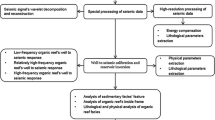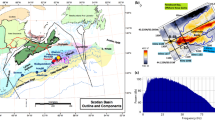Abstract
Organic reefs are developed in the Changxing Formation (Fm.) in the southeastern end of the Kaijiang-Liangping ocean trough, eastern Sichuan. Due to the ambiguous seismic reflection characteristics of organic reefs, application of organic reef recognition methods that have been successfully employed in other areas is limited in the study area, but these methods can still indicate development of favorable facies zones. Accordingly, supplemented by seismic reflection characteristics analysis, seismic attributes analysis and time-difference analysis, frequency decomposition and reconstruction interpretation technique, high-frequency uncompressing method, and dominant azimuth lightening method were optimized to be the core technologies of enhanced and fine depiction technique system of organic reefs. The technique system transforms seismic data from the time and reflection angle domain to the frequency and azimuth-offset domain; increases the differences in seismic reflection characteristics in and out of organic reefs, especially patch reefs of small volume and low recognition; enhances seismic reflection characteristics of both the outline especially the lateral boundary and interior of organic reefs; and achieves precisely depicting the boundary of organic reefs and fine recognition of the internal structure of platform margin facies reefs such as reef core, fore reef, and back reef. This technique system provides a new technical idea for organic reef recognition, has produced optimistic recognition effects in the study area, and is of certain guidance significant to the research into recognition of organic reefs with ambiguous seismic reflection characteristics.







Similar content being viewed by others
References
Balch AH (1971) Color sonograms: A new dimension in seismic data interpretation. Geophysics 36(6):1074–1098
Bi CC, Li LX, Mei Y, Zhang YC, He C (2007) Geological control factors of Changxing organic reef distribution and seismic prediction techniques, east Sichuan Basin. Nat Gas Geosci 18(4):509–513
Brown AR (1996) Seismic attribute and their classification. Lead Edge 15(10):1090–1098
Che Q, Liu HY, Wen L, Mao XP (2012) Bioreef gas reservoir type of Changxing formation in Gaofengchang area, Sichuan basin. Nat Gas Explor Dev 35(3):13–16 23
Chen Q, Sidney S (1997) Seismic attribute technology for reservoir forecasting and monitoring. Lead Edge 16(5):445–446
Chen XH, He ZH, Huang DJ (2008) High-efficient time-frequency spectrum decomposition of seismic data based on generalized S transform. Oil Geophys Prospect 43(5):530–534
Chopra S, Marfurt KJ (2005) Seismic attributes-a historical perspective. Geophysics 70(5):3–28
Daubechies I (1988) Orthonormal bases of compactly supported wavelets. Commun Pure Appl Math 41:909–996
Ding CQ (2018) Application of seismic sedimentology in organic reef reservoirs: a case study of Changxing formation of Permian system in Damaoping area, east Sichuan. In: Abstracts of the 15th National Conference on Paleogeography and Sedimentology. Southwest Petroleum University, Chengdu, China
Fan JS, Zhang W (1985) On the basic concept and classification of organic reefs and their main identifying criteria. Acta Pet Sin 1(3):45–59
Fan C, Qin Q, Hu D, Wang X, Zhu MY, Huang W, Li Y, Ashraf MA (2018) Fractal characteristics of reservoir structural fracture: a case study of Xujiahe formation in central Yuanba area, Sichuan basin. Earth Sci Res J 22(2):113–118
Feng YW, Qu HJ, Zhang GC, Pu RH (2017) Seismic interpretation and hydrocarbon accumulations implication of the Miocene Meishan formation reefs in southern Qiongdongnan basin, northern South China Sea. J Palaeogeogr 6(3):206–218
Gao JH, Chen WC, Li YM, Tian F (2003) Generalized S transform and seismic response analysis of thin interbeds. Chin J Geophys 46(4):526–532
Gong S. Y., 2019. Research and application of prediction methods for the complex reef reservoir based on 3D seismic data. Chengdu, China: Chengdu University of Technology, Master Thesis
Koenig W, Dunn HK, Lacy LY (1946) The sound spectrograph. J Acoust Soc Am 18(1):19–49
Li M (2012) Permian biological reef reservoir seismic prediction research in JG block of Sichuan basin. Chengdu, China: Chengdu University of Technology, PhD. Thesis
Li T, Yin XZ (2009) Analysis on the geological significance of seismic attributes. Complex Hydrocarb Reserv 2(3):25–28 36
Lin LB (2014) Tectonic sequence framework and sedimentary basin evolution of upper Triassic in the Sichuan basin, China. BioTechnol 10(8):2554–2565
Liner C, Li CF, Gersztenkorn A (2004) SPICE: a new general seismic attribute. USA: SEG Technical Program Expanded Abstracts 23(1):33–436
Liu W (2017) Distribution law of organic reef and optimization of exploration target of Changxing formation in east Longgang area. Chengdu, China: Southwest Petroleum University, Master Thesis
Liu S, Tang JM, Ma YS, Zhao S (2006) Prediction of reef and shoal facies reservoirs in Changxing-Feixianguan formations in northeastern Sichuan basin. Oil Gas Geol 27(3):332–338
Liu GP, You YC, Feng L, Wang D (2017) Fine depict of reef reservoirs in Changxing formation, Yuanba area. Oil Geophys Prospect 52(3):583–590
Mallat S (1988) Multiresolution and Wavelets. Philadelphia: University of Pennsylvania, PhD. Thesis
Mallat S (1989) Multifrequency channel decompositions of images and wavelet models. IEEE Trans Acoust Speech Signal Process 37(12):2091–2110
Mallat S (1998) A wavelet tour of signal processing. Academic, New York
Morlet J, Arens G, Fourgeau E, Glard D (1982a) Wave propagation and sampling theory - part I: complex signal and scattering in multilayered media. Geophysics 47(2):203–221
Morlet J, Arens G, Fourgeau E, Glard D (1982b) Wave propagation and sampling theory - part II: sampling theory and complex waves. Geophysics 47(2):222–236
Ostrander WJ (1984) Plane wave reflection coefficients for gas sands at non-normal angles of incidence. Geophysics 49(10):1637–1648
Peng C, Wen QB, Cao BC, Zhang YC (2013) Seismic prediction of reef in Changxing formation of Gaofengchang area, eastern Sichuan basin. Geophys Prospect Pet 52(2):207–211
Pinnegar CR, Mansinha L (2003) The S-transform with windows of arbitrary and varying shape. Geophysics 68(1):381–385
Potter RK (1945) Visible patterns of sounds. Science 102(2654):463–470
Ruger A (1998) Variation of P-wave reflectivity with offset and azimuth in anisotropic media. Geophysics 63(3):935–947
Sejdić E, Djurović I, Jiang J (2008) A window width optimized S-transform. EURASIP J Adv Signal Process 208(10):1–13
Stockwell RG, Mansinha LP, Lowe R (1996) Localization of the complex spectrum: the S Transform. IEEE Trans Signal Process 44(4):998–1001
Taner MT, Koehler F, Sheriff RE (1979) Complex seismic trace analysis. Geophysics 44(6):1041–1063
Taner MT, Schuelke JS, Doherty RO, Baysal E (1994) Seismic attributes revisited. USA: SEG Technical Program Expanded Abstracts, 13(1):1104–1106
Wang QY, Cai ZQ (2007) Study on organic reef reservoir of Changxing formation of Gaofengchang field in eastern Sichuan. J Oil Gas Technol 29(3):192–195
Wang KY, Xu QY, Zhang GF, Cheng MC, Li PH (2013) Summary of seismic attribute analysis. Prog Geophys 28(2):815–823
Williams M, Jenner E (2002) Interpreting seismic data in the presence of azimuthal anisotropy; or azimuthal anisotropy in the presence of the seismic interpretation. Lead Edge 21(8):771–774
Wu YS, Fan JS (1991) Definition and classification of reefs. Oil Gas Geol 12(3):346–349
Xu SB (2016) Prediction of reef reservoir of Changxing formation in F area, northeastern Sichuan basin. Chengdu, China: Chengdu University of Technology, Master Thesis
Yan Y, Gu S, Yingna Z, Qingpeng D (2014) Application of BP neural network for the design of isolated structure. BioTechnol 10:275–280
Yin JF (2008) Geological characters and seismic prediction technique of the Permian reefs in east Sichuan. Beijing, China: China University of Geosciences, PhD. Thesis
Yin JF, Li J, Xie F, Cheng Y, Li DH (2007) Application of waveform classification technique in predicting reef gas pool in east Sichuan basin. Geophys Prospect Pet 46(1):53–57 73
Yu MJ (2016) Application research of separate frequency seismic attributes in fractured reservoir prediction. China University of Petroleum, Master Thesis, Beijing, China
Zeng DQ, Liu BW, Huang YM (1988) Organic reefs in various geological periods in China. Petroleum Industry Press, Beijing
Zhao BL, Du XD (2009) Geological characteristics and geophysical identification of biological reef. Petroleum Industry Press, Beijing
Zhao Z, Wang SJ, Zhang YC, Li JZ (2014) Study on the technology for prediction of the favorable reef facies belt in Changxing formation in the east of Sichuan. Offshore Oil 34(1):41–45
Zhu PY (2016) Study on seismic identification of organic reefs in the upper Permian Changxing Formation on the eastern side of the Kaijiang-Liangping trough. Chengdu, China: Southwest Petroleum University, Master Thesis
Acknowledgements
The data of this study are provided by Beijing Tiangong Xinyuan Technology Co., Ltd. Thanks to Li Zhiguo and Shu Lv for their great help. Also, thanks are given to the reviewers and editors for their constructive suggestions.
Author information
Authors and Affiliations
Corresponding author
Additional information
This article is part of the Topical Collection on Geological Modeling and Geospatial Data Analysis
Rights and permissions
About this article
Cite this article
Cheng, L., Yang, J. & Wang, Y. Enhanced and fine seismic recognition of organic reefs: a case study of the Changxing Formation, eastern Sichuan, China. Arab J Geosci 13, 899 (2020). https://doi.org/10.1007/s12517-020-05888-5
Received:
Accepted:
Published:
DOI: https://doi.org/10.1007/s12517-020-05888-5




